A major element of Bauvals evidence is the optical similarity between the Giza pyramids and the stars of Orion's belt. This begins with the comparative height of the pyramids:
"The relationship between the pyramid heights is exactly the same as the relationship of the brightness of the belt stars of Orion: "Not only did the layout of the pyramids match the stars with uncanny precision but the intensity of the stars, shown by their apparent size, corresponded with the Giza groupů".[ 1 ]
According to Bauval the ratio of the sizes of the pyramids is the same as the ratio between the brightness' of the corresponding stars. Unfortunately, Bauval doesn't say what he exactly means by "size": volume, surface area or height? Height would be the most natural choice, but let's start with the alternatives.
The optical impression of Orion's belt is that of three approximately equally bright stars, one seems to be a little dimmer for the untrained eye.
If we use the volume of the pyramids as "size", the third star had to have only 10% of the brightness of the other stars, because Menkaures pyramid has only 10% of the volume of Khufu's, which clearly isn't what's seen in the sky. The same goes for the surface area - since the 3rd pyramid has only 20% of the surface of Khufu's, the 3rd star would have only 20% of the brightness. Even if we compare the covered area, the base squares, the difference would be too large since Menkaures pyramid has about 1/2 the base square size of Khufus. So "size = height" is not only the most natural, but also the only logical way to compare stars and pyramids.
Another problem: I was not able to find any exact data about the magnitude of the stars in Bauval's book, he only repeats that the brightness ratios match the size ratios. If so, we would be dealing with two stars of nearly similar magnitude and one with about 50% of the magnitude of the others.
But this contradicts atronomical tables such as the Yale catalogue of bright stars (3rd Edition) or the data from my astronomy program Redshift:
| Star | Pyramid | mag Yale | mag Redshift |
|---|---|---|---|
| Zeta ORI | Khufu | 2.05 | 2.00 |
| Epsilon ORI | Kaphre | 1.70 | 1.70 |
| Delta ORI | Menkaure | 2.2 - 2.7 (var) | 2.50 |
Mintaka, the star of Menkaure, is varaiable with a magnitude between 2.2 and 2.7.
The magnitude (mag) of a star can reach values between 5 and -1. A magnitude of 5 is the faintest star visible to the naked eye, whereas Sirius, the brightest star in the sky, reaches -1 mag. The magnitude scale is not a modern invention, it dates back to the Babylonian astronomers who invented it to classify stars with the naked eye. A difference in brightness of one mag represents a doubling of the subjective brightness between these stars.Since our eye does not work linear, there is a difference between the visible brightness and the measurable liht intensity, you have to use a logarithmic function to compare them.
Good amateur astronomers can estimate the brightness of a star to 0.2 mag, but differences in magnitudes between neighbouring stars can be estimated to 0.05 mag. If the Egyptians had a desire to build pyramids according to the brightness of stars, they could have achieved it to within an error of 5-10% without problems
But as you can see in the table above, al-Nitak is between 30 and 35% less bright than al-Nilam. Therefore we would expect Khufu's pyramid to be at least 25-30% lower than Khafre's. And Menkaure's pyramid should be about 50% lower than Khufu's. We would expect one large pyramid in the middle, accompanied by two smaller ones. Let's calculate the pyramid heights according to the brightness of their stars. I will set Khafre's pyramid with its 143 m as 100%:
| Pyramid | Should-be height | true height | Error |
|---|---|---|---|
| Khufu | 93 - 100 m | 146,6 m | 46 - 57% |
| Menkaure | 46 - 50 m | 66,5 m | 33 - 45% |
The errors are clearly too big for a planned correlation; nearly 60% error in the height of Khufu's pyramid, and 50% in that of Menkaure - never ! The nice idea of height/brightness-correlation, therefore, is WRONG!
Note: I subsequently found some other astronomical tables with differing magnitudes, giving between 1.6 and 1.7for al-Nilam, and between 1.8 and 2.0 for al-Nitak. But in all these tables the differences between the two stars remain...
Bauval claims, that the 3rd pyramid, Menkaures, has been built with a clearly visible deviation in respect to the other pyramids. This should be a sign that the pyramids in fact represent the slightly bent belt of Orion:
"All agree that the size and offset of the Menkaura pyramid had been a deliberate choice by the architect. The question was why ?"[ 2 ]
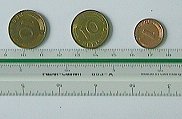
|
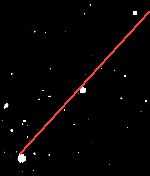
|
Bauval claims that Menkaure's pyramid deviates from the diagonal of the other two pyramids. But let me first ask: What does "deviates" mean? Let's place three coins along a ruler, like in this picture with two 10-Pfennig pieces and one 1-Pfennig coin. Does the smaller coin deviate from the other? The centre does, and so does the upper line, but not the lower line. A real deviation would occur if all 3 major points of this coin were off-axis: upper, centre, lower. Like, for example, the third star in Orion's belt.

|
We looked at the so-called Giza diagonal earlier. The south-east corners of the three big pyramids are, together with the center of the first satellite pyramids of Menkaure and Khufu and the center of a mysterious building called "Mauerblock" with only a few meters deviation on a line which points into the heart of the old capital Iunu. So we have a situation like with the coins and the ruler - Menkaure's pyramid has no real deviation.
There is another diagonal there. If you connect the centers of the two large pyramids you get a line which, if drawn longer, touches the nortwest corner of Menkaures pyramid.
Strange, I remembered another picture from a TV production, where you actually could see a real deviation, and in his book Bauval also argues about real deviations for a couple of pages. Well, there is a very tiny picture, not much larger than a stamp. Its "Figure 12" in the German edition and much too small to make real measurements, but when you abbly a ruler to the SE-corners of the two large pyramid you can see a real deviation of the third pyramid even there. But there is hope. In 1989 Bauval wrote an article for Discussions in Egyptology, No. 13, and there is a large sketch (his fig. 2).
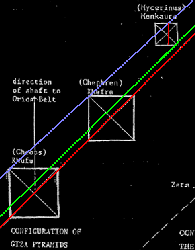
|
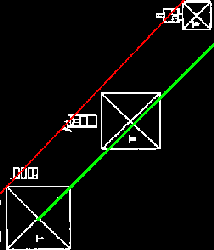
|
Yes, the situation is different. The southeast-diagonal pierces through Menkaures pyramid and leaves the south side even west of the center. That's definitively wrong. And the second diagonal comes not even near the pyramid base.
The reason for this can be found if we compare the plans: Bauval ises a different angle for the line connecting the centers of the large pyramids, settin Kaphres pyramid slightly to the west. This way he created with a few meters "correction" on the second pyramid a large dewiation on the third one. In Fig. 15 I transfered the angle Bauval had used to the other plan - and it creates exacly the deviations we have seen. This pyramid shifting is even less explainable than the value bending of Gantenbrink's measurements.
By the way: Only because all three pyramids are aligned so well we get this impressive "nine pyramid view" from where Khufu's and Menkaure's pyramid almost look af if they have the same height....
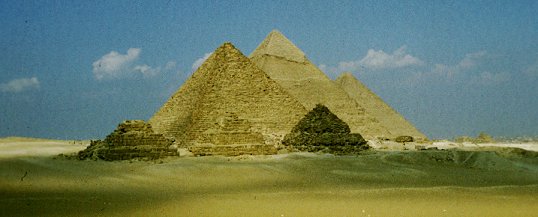
This piece of evidence ist WRONG AGAIN!

|
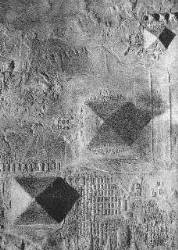
|
Bauval uses these two pictures to show that there is a match between the belt stars of Orion and Giza. But why does he use such a crappy photo of Orion to show this? I found this picture in a book about the history of astronomy, as the first picture ever taken of Orion.
When we compare a modern picture with the pyramids we can see why Bauval used the old one. The stars are smeared up to big blobs of about pyramid size, the diameter of the objects are a similar size to the pyramids at Giza. And you cannot really compare the centres of the pyramids and stars. Let's look at it when we compare it with a modern photo of Orion.
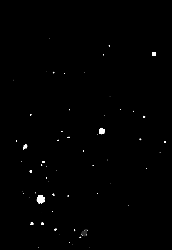

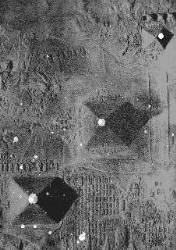
The impression is totally different. Now we have three sharp, small, distinctive discs, much farther away from each other than their virtual diameter. Just like the view in the sky. Three squat pyramids sitting side by side do not give the same overall impression The proto-obelisks from the solar temples like Abu Gurob would have been more fitting.
We can see another irritating point: Around the belt stars there are several bright clusters, and on the Giza plateau we have lots of satellite pyramids and mastabas. But we do not have a single match. I would have expected something, because some of these buildings are for the sons, daughters and wives of the great pharaohs. Why is there no match with the lesser Orion stars? There was enough room...
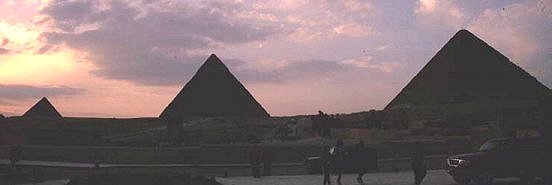
This is the view from the valley temple of the pyramids in the east. Do you see that the summit of the third pyramid is not aligned with the other two?


To see it you have to wander into the desert for about 2 kilometres, to the west of the hill with the "9 pyramid view". To give as massive deviation as the stars, Menkaure's pyramid would have had to have been built at least 100 m further east.
This idea, too, is WRONG!